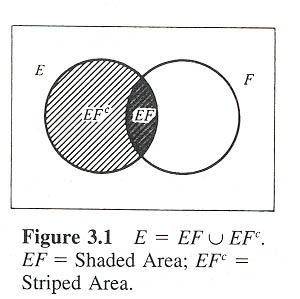Bayes' Formula 貝氏公式
設 E 和 F 為兩事件. 我們可將 E 表示成

因為 E 中的點, 必定同時在 E 與 F 中或在 E 但不在 F 中. 如圖:
因 EF 和 EFc 很明顯的是互斥事件, 所以由 Axiom 3 可得
Equation (3.1) states that the probability of the event E is a weighted
average of the conditional probability of E given that F has occurred and
the conditional probability of E given that F has not occurred -- each
conditional probability being given as much weight as the event that it is
conditioned on has of occurring.
- Example
- 考多重選擇時, 學生可能知道答案, 也可能用猜的. 設學生知道答案的機率為 p,
猜答案的機率為 1-p. 假設學生猜對答案的機率是
 ,
其中,
m 為選擇題的選項數. 若學生答對某題, 試求他知道答案的機率為多少?
,
其中,
m 為選擇題的選項數. 若學生答對某題, 試求他知道答案的機率為多少?
- Solution:
- 令 C 和 K 分別表示學生答對題目和他確實知道答案的事件, 則
因此, 若
 ,
則學生對於他所答對的問題,
確實知道其答案的機率為
,
則學生對於他所答對的問題,
確實知道其答案的機率為
 .
.
![$\rule[0.02em]{1.0mm}{1.5mm}$](img7.gif)
![]()

![$\begin{array}{rcl}
P(E)&=& P(EF) + P(EF^c) \\ \\
&=& P(E\vert F)P(F) + P(E\ver...
... \\
&=& P(E\vert F)P(F) + P(E\vert F^c)[1-P(F)] \qquad (3.1)\\ \\
\end{array}$](img2.gif)
